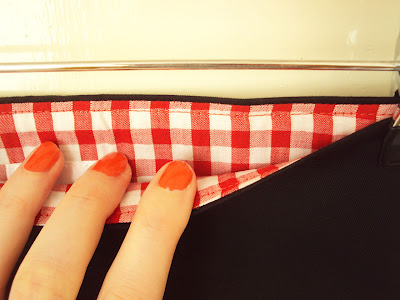You don't have to have a dictionary close to hand to figure out that 'refashioning' and 'mending' are not the same thing. However, I feel they come from a similar enough angle to justify going on a slight mending tangent this week. They are, after all, both about extending the longevity of existing garments.
I am a sewer who doesn't get particularly excited about mending. I could be spending that time working on a brand new exciting project. When I do get round to mending, it is with reluctance. However, I have been lucky enough to meet someone who feels very differently about mending, someone who relishes the challenge of a holey jumper or ripped jacket, and has gone to great length to study and master many of the long forgotten mending techniques our grandmothers and great grandmothers were probably dab hands at. I am talking about Tom of Holland.
(Tom mending some shoes)
As well as a mending and darning sensei Tom is also a total master at knitting, and he teaches all these things here at Super+Super HQ in Brighton, although he can also been found sharing his knowledge at other locations. He has developed a concept that I find super interesting: the Visible Mending Programme, which Tom explains thus:
''The Visible Mending Programme seeks to highlight that the art and craftsmanship of clothes repair is particularly relevant in a world where more and more people voice their dissatisfaction with fashion’s throwaway culture. By exploring the story behind garment and repair, the Programme attempts to reinforce the relationship between the wearer and garment, leading to people wearing their existing clothes for longer, with the beautiful darn worn as a badge of honour. By writing this blog, running darning workshops and taking repair work commissions I provide mending inspiration, skills and services to people and hopefully persuade them that shop-bought clothes deserve care and attention too, just like a precious hand-knit.''
(Tom's impressive collection of darning tools)
Tom has also started sewing clothing, and with his tenacity and eye for detail no doubt he will soon be a total legend at that too. But right now, whilst I still have some knowledge I can offer him, we brokered a deal: I would help him with some of his sewing and fitting dilemmas and in return, he would teach me to darn properly! A few years ago, I came to the conclusion that I needed to learn how to darn my socks, but after a fairly poor attempt, I admit I gave up. But since conquering how to make so many of my own clothes and largely no longer relying on buying mass-produced items, I want to push that even further, and being able to properly darn my existing socks is something I am now re-inspired to do.
Tom has a vast collection of books on knitting, darning and mending techniques. My own tiny collection of related books is pictured above! I've long been obsessed with the public information pamphlets that were released during the second world war to show the population how to make the best of their restricted rations and resources. Both these books are basically compilations of those original govverment issued pamphlets. Their illustrations are awesome, and as pieces of social history I think they are priceless. I was thrilled when I discovered the darning technique Tom was to show me was basically the same as the one in the 1940's picture below.
I brought along two poorly socks, Tom took the one with the biggest hole. This is the sock I started with (pictured below). This pair of socks are actually men's golfing socks that I was given over ten years ago, and although this may sound weird, I have some significant memories attached to these socks! But the sheer fact that they have lasted well over a decade prove that they deserve some investment on my part to extend their life still further!
Obviously this mend was intended to be a visible one, so I chose a burgundy darning floss and set to work following Tom's instructions. I was heartened to find out that, once Tom started showing me the best technique for mu holey sock, that I had been on the right lines with my previous attempts to darn, just that I had been using the wrong type of mending yarn (which I knew) and that my stitches had been too far apart.
I should mention that all this darning went on whilst the sock was turned through to the wrong side. It's looks like a whole crazy mass of yarn from the inside (I'll get neater with practice, I'm sure) but you can kind of see the grid I created.
Turned through the right way and it looks really cool! The contrast colour is peeking through. After washing the darning floss goes more woolly and a bit matted which helps to plug the hole further.
I've properly caught the darning bug now. I've even asked for a darning mushroom and floss for Christmas! I feel guilty about all those otherwise perfectly good socks I've binned in the past that could have lived on much longer if I'd figured all this out earlier. What about you? Do you darn? Do you prefer a visible or invisible approach?

















-1.jpg)
.jpg)

































